Caryn
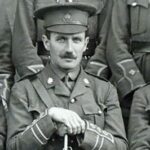
 World War I was a different era, even in the way war was conducted. Oh, war is still war, and there is wounding, bombing, killing, and capturing. Nevertheless, with one leader, Kaiser Wilhelm II, there was also compassion. After being captured and placed in a POW camp, a British officer, Captain Robert Campbell found out that his mother was dying. He couldn’t bear the thought of not seeing his mother before she passed away, and in his grief, he took a chance. He appealed to Kaiser Wilhelm II, asking to be allowed to go home to visit his mother before she died. Amazingly, Kaiser Wilhelm II granted his request, on the condition that he return to the POW camp after the visit.
World War I was a different era, even in the way war was conducted. Oh, war is still war, and there is wounding, bombing, killing, and capturing. Nevertheless, with one leader, Kaiser Wilhelm II, there was also compassion. After being captured and placed in a POW camp, a British officer, Captain Robert Campbell found out that his mother was dying. He couldn’t bear the thought of not seeing his mother before she passed away, and in his grief, he took a chance. He appealed to Kaiser Wilhelm II, asking to be allowed to go home to visit his mother before she died. Amazingly, Kaiser Wilhelm II granted his request, on the condition that he return to the POW camp after the visit.
When you think about it, once he was safely home with his mother, Captain Campbell could have simply stayed. Seriously, what could the Kaiser have done about it. Nevertheless, being an honorable man, Captain Campbell kept his promise to Kaiser Wilhelm II and returned from Kent to Germany after visiting his mother for a week. He stayed at the camp until the war ended in 1918. That was not the end of the story, however.

On August 24, 1914, then 29-year-old Captain Campbell, of the 1st Battalion East Surrey Regiment, was captured in northern France. He was sent to a prisoner-of-war (POW) camp in Magdeburg, north-east Germany. It was there that he received the heartbreaking news that his mother, Louise was dying of cancer. Captain Campbell traveled through the Netherlands and then by boat and train to Gravesend in Kent, where he spent a week with his mother before returning to Germany the same way. His mother died in February 1917.
With the kindness of the Kaiser, and a duty to honor his word, Captain Campbell, knowing that if he didn’t return, no one else would ever be given that same consideration, Captain Campbell returned to Germany. Strangely, there was no issues during his return. I suppose the Kaiser could have cleared the way previously, but it would be my guess that the Kaiser was just as shocked by the return as I am. Unfortunately, Britain wasn’t as considerate, because they blocked a similar request from German prisoner Peter Gastreich, who was being held at an internment camp on the Isle of Man. After that no other British prisoners of war were afforded compassionate leave.
As for Captain Campbell, while he felt duty-bound to return to captivity, he did not feel duty-bound to stay in 
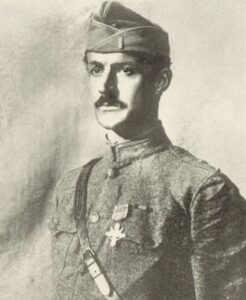 captivity. As soon as Captain Campbell returned to the camp, he set about trying to escape. He and a group of other prisoners spent nine months digging their way out of the camp before being captured on the Dutch border and sent back. He remained in the camp until 1918 and served in the military until 1925. Captain Campbell rejoined the military when World War II broke out in 1939 and served as the chief observer of the Royal Observer Corps on the Isle of Wight. He died in the Isle of Wight in July 1966, aged 81.
captivity. As soon as Captain Campbell returned to the camp, he set about trying to escape. He and a group of other prisoners spent nine months digging their way out of the camp before being captured on the Dutch border and sent back. He remained in the camp until 1918 and served in the military until 1925. Captain Campbell rejoined the military when World War II broke out in 1939 and served as the chief observer of the Royal Observer Corps on the Isle of Wight. He died in the Isle of Wight in July 1966, aged 81.
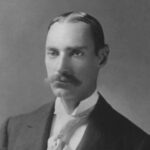
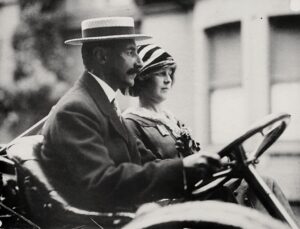 John Jacob Astor IV was born on July 13, 1864 at his parents’ country estate of Ferncliff in Rhinebeck, New York. He was the youngest of five children and only son of William Backhouse Astor Jr, a businessman, collector, and racehorse breeder/owner, and Caroline Webster “Lina” Schermerhorn, a Dutch-American socialite. His four elder sisters were Emily, Helen, Charlotte, and Caroline (“Carrie”). John Astor IV was an American business magnate, real estate developer, investor, writer, lieutenant colonel in the Spanish–American War. He came from a long line of the very prominent Astor family.
John Jacob Astor IV was born on July 13, 1864 at his parents’ country estate of Ferncliff in Rhinebeck, New York. He was the youngest of five children and only son of William Backhouse Astor Jr, a businessman, collector, and racehorse breeder/owner, and Caroline Webster “Lina” Schermerhorn, a Dutch-American socialite. His four elder sisters were Emily, Helen, Charlotte, and Caroline (“Carrie”). John Astor IV was an American business magnate, real estate developer, investor, writer, lieutenant colonel in the Spanish–American War. He came from a long line of the very prominent Astor family.
Astor’s was an accomplished writer, having published “A Journey in Other Worlds” (1894), a science-fiction novel about life in the year 2000 on the planets Saturn and Jupiter. He was also an inventor. He patented several inventions, including a bicycle brake in 1898, a “vibratory disintegrator” used to produce gas from peat moss, and a pneumatic road-improver, and he helped develop a turbine engine. He was a great visionary, and his contributions to the world were amazing. 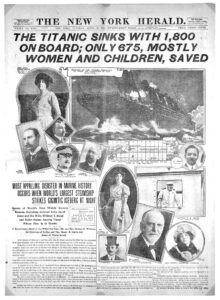
Astor married socialite Ava Lowle Willing on February 17, 1891. The couple had two children, William Vincent Astor (November 15, 1891 – February 3, 1959), businessman and philanthropist, and Ava Alice Muriel Astor (July 7, 1902 – July 19, 1956). The couple divorced in November 1909. Astor IV remarried shortly thereafter, compounding the scandal of his divorce. At the age of 47, Astor married 18-year-old socialite Madeleine Talmage Force, the sister of real estate businesswoman and socialite Katherine Emmons Force. Astor and Force were married in his mother’s ballroom at Beechwood, the family’s Newport, Rhode Island, mansion. There was also much controversy over their 29-year age difference. His son Vincent despised Force, yet he served as best man at his father’s wedding. The couple took an extended honeymoon in Europe and Egypt to wait for the gossip to calm down. Among the few Americans who did not spurn him at this time was Margaret Brown, later fictionalized as The Unsinkable Molly Brown. She accompanied the Astors to Egypt and France. After receiving a call to return to the United States, Brown accompanied the couple back home aboard RMS Titanic.
Astor IV died in the sinking of the RMS Titanic during the early hours of April 15, 1912. Astor was the richest passenger aboard the RMS Titanic and was thought to be among the richest people in the world at that time. He was also a true gentleman, who would never have been on a lifeboat without knowing that all the women and children were on lifeboats. Astor IV had a net worth of roughly $87 million when he died, which would be 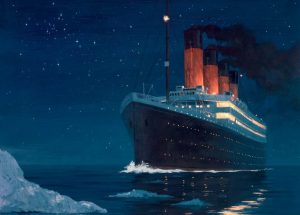
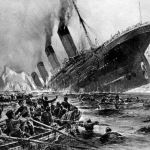 equivalent to $2.44 billion in 2021. Astor, like his predecessors also made millions in real estate. In 1897, Astor built the Astoria Hotel, “the world’s most luxurious hotel”, in New York City, adjoining the Waldorf Hotel owned by Astor’s cousin and rival, William. Later, the complex became known as the Waldorf-Astoria Hotel. The Waldorf-Astoria was the host location to the United States inquiries into the sinking of the RMS Titanic, on which Astor died.
equivalent to $2.44 billion in 2021. Astor, like his predecessors also made millions in real estate. In 1897, Astor built the Astoria Hotel, “the world’s most luxurious hotel”, in New York City, adjoining the Waldorf Hotel owned by Astor’s cousin and rival, William. Later, the complex became known as the Waldorf-Astoria Hotel. The Waldorf-Astoria was the host location to the United States inquiries into the sinking of the RMS Titanic, on which Astor died.

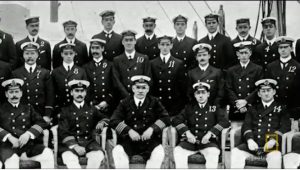 When we are going through things that others have gone through, it can be extremely helpful to listen to what they know. That advise is important for everyone, everywhere, because if we don’t listen and heed those warnings, we might just find ourselves learning a very hard lesson…that hindsight is always 20/20.
When we are going through things that others have gone through, it can be extremely helpful to listen to what they know. That advise is important for everyone, everywhere, because if we don’t listen and heed those warnings, we might just find ourselves learning a very hard lesson…that hindsight is always 20/20.
On April 14th, 1912, SS Mesaba, a ship on the same route as RMS Titanic had traveled through waters with dangerous icebergs floating around just a few hours before Titanic was to be there. The Mesaba sent out a warning about icebergs to every ship in the area, including 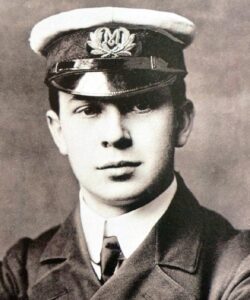 the Titanic. The message went out, and the crew of the Titanic received it, but the radio operator who received the message didn’t think it was important enough to deliver to the captain. This was probably because the Titanic’s radiomen were very busy. The passengers were sending and receiving messages with the mainland. It was a show of prestige. Even with the busy day, one would think that a message about an unusually high number of icebergs would have gone into the “high priority” pile, but of course hindsight is always 20/20. I’m sure that if John George Phillips, the Titanic’s senior wireless operator, had known then what he soon would know, he would have rushed the message to the captain immediately.
the Titanic. The message went out, and the crew of the Titanic received it, but the radio operator who received the message didn’t think it was important enough to deliver to the captain. This was probably because the Titanic’s radiomen were very busy. The passengers were sending and receiving messages with the mainland. It was a show of prestige. Even with the busy day, one would think that a message about an unusually high number of icebergs would have gone into the “high priority” pile, but of course hindsight is always 20/20. I’m sure that if John George Phillips, the Titanic’s senior wireless operator, had known then what he soon would know, he would have rushed the message to the captain immediately.
So many things would likely have been different, if people had only known what the future would bring. People wouldn’t have even been on the Titanic had they known. Then again, if the crew had known that an iceberg could do so much damage to an “unsinkable” ship, they would have listened when they were warned of very serious danger lurking in the waters ahead of them. They would have been crawling through the area, or they would have stopped for the night. They certainly wouldn’t have been pushing the ship to near maximum speed in an area of ocean that was filled with icebergs as dangerous as a floating mine or a torpedo. Unfortunately, hindsight is always 20/20, and the only reason we know the dangers now, is that the ship is at the bottom of 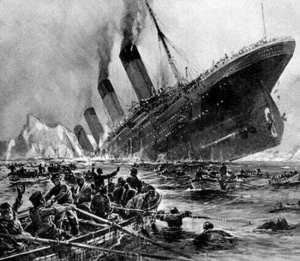
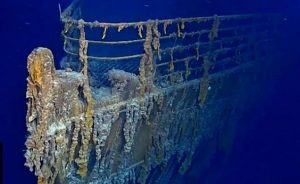 the ocean, having succumbed to the very fate everyone was so sure could never happen to the great Titanic.
the ocean, having succumbed to the very fate everyone was so sure could never happen to the great Titanic.
We can’t always know the dangers that lie ahead of us, but it is a wise man that pays attention to warnings of danger so that appropriate action can be taken. We can live with the saying, hindsight is always 20/20, or we can do our very best not to have to see that 20/20 hindsight with great regret.
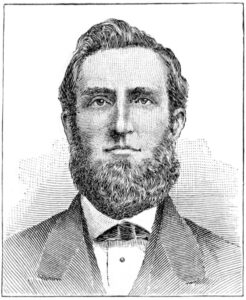
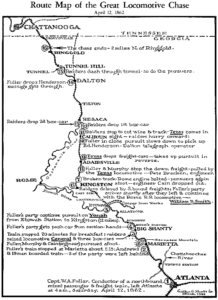 During the Civil War, things like supply lines and lines of communication were crucial to both sides. The railroads became an important asset, as well as a liability, to both sides, depending on what they were carrying and where it was headed. On April 12, 1862, volunteers from the Union Army, led by civilian scout James J Andrews, commandeered a train called The General, and took it northward from Georgia toward Chattanooga, Tennessee. En route, they did as much damage as possible to the vital Western and Atlantic Railroad (W and A) line from Atlanta to Chattanooga. They were pursued for 87 miles by Confederate forces, trying at first to keep up on foot, and later resorting to a succession of locomotives, including The Texas.
During the Civil War, things like supply lines and lines of communication were crucial to both sides. The railroads became an important asset, as well as a liability, to both sides, depending on what they were carrying and where it was headed. On April 12, 1862, volunteers from the Union Army, led by civilian scout James J Andrews, commandeered a train called The General, and took it northward from Georgia toward Chattanooga, Tennessee. En route, they did as much damage as possible to the vital Western and Atlantic Railroad (W and A) line from Atlanta to Chattanooga. They were pursued for 87 miles by Confederate forces, trying at first to keep up on foot, and later resorting to a succession of locomotives, including The Texas.
Known as The Great Locomotive Chase, the military raid was also called the Andrews’ Raid or Mitchel Raid (after Major General Ormsby Mitchel, who had earlier assisted in the capture of Nashville and accepted the surrender of the city). In the end, as often happens in escapades like this, the raid made sensational headlines in newspapers, but it really had little impact on the war. It didn’t stop supply lines for the South or start new ones for the North.
In February, the Union soldiers captured Fort Henry and Fort Donelson, and Confederate General Albert Sidney Johnston knew he had to withdraw his forces from central Tennessee to reorganize. Johnston evacuated Nashville on February 23rd, and Nashville became the first Confederate state capital to fall to the Union. For Major General Don Carlos Buell, the taking of Nashville was enough, and on March 11th, Buell’s army was merged into the new Department of the Mississippi under General Henry Halleck. It was then that James J Andrews, a Kentucky-born civilian serving as a secret agent and scout in Tennessee approached Buell with a plan to take eight men to steal a train in Georgia and drive it north. Buell authorized the expedition in August 1863. Andrews, a train engineer in Atlanta, was willing to defect to the Union with his train, and without Andrews, taking over the train would have proved difficult. Getting onboard would have been easy enough, but running the train without experienced personnel is next to impossible. Since Andrews was willing to defect, he might also be able to supply a volunteer train crew to assist in running the train, tearing up track, and burning 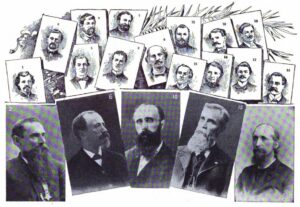 bridges, so they would have an even greater chance of succeeding. The main target of the operation was the railway bridge at Bridgeport, Alabama, but Andrews had several other bridges in Georgia and Tennessee in mind too. Some of the men from Major General Mitchel’s division, encamped at Murfreesboro, Tennessee, were tapped to be the volunteers for this first raid.
bridges, so they would have an even greater chance of succeeding. The main target of the operation was the railway bridge at Bridgeport, Alabama, but Andrews had several other bridges in Georgia and Tennessee in mind too. Some of the men from Major General Mitchel’s division, encamped at Murfreesboro, Tennessee, were tapped to be the volunteers for this first raid.
The group of raiders moved south forty miles on foot to the Confederate railhead at Tullahoma. Then the caught a train to Marietta, Georgia. It was then that the operation hit its first snag, when Andrews discovered the engineer had been pressed into service elsewhere. Upon inquiring if any of the raiders knew how to operate a locomotive, they found that none did, and the raid was called off. Two raiders were also confronted by Confederate soldiers while trying to cut the telegraph lines, but successfully pretended to be overworked wiremen. Then the raiders returned north to Union lines, arriving about a week after they had departed. Andrews spent several days rearranging the operation and conducting reconnaissance on the Western and Atlantic Railroad before he headed north to federal lines too. The original raiders all refused to volunteer for the second raid, fearing the enemy. One said that “he felt all the time he was in the enemy’s country as though he had a rope around his neck.”
While the first raid was a bust, the second raid went off pretty well. The General was taken while the crew was a breakfast at the Lacey Hotel in Atlanta, and despite all the efforts to catch them, it arrived at milepost 116.3, north of Ringgold, Georgia, just 18 miles from Chattanooga and out of fuel. Andrews’s men abandoned The General and scattered. Andrews and all of his men were caught within two weeks. They even caught two volunteers who had the hijacking. Mitchel’s attack on Chattanooga was a failure.
All of the raiders were charged with “acts of unlawful belligerency.” The civilians among them were charged as unlawful combatants and spies. They were tried in military courts or courts-martial. Andrews was tried in 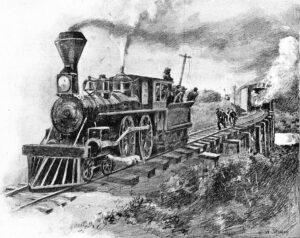
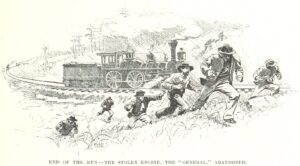 Chattanooga, found guilty, and hanged on June 7 in Atlanta. Seven others were transported to Knoxville and convicted as spies. They were returned to Atlanta and were hanged too. Their bodies were buried unceremoniously in an unmarked grave. Those bodies were later reburied in Chattanooga National Cemetery.
Chattanooga, found guilty, and hanged on June 7 in Atlanta. Seven others were transported to Knoxville and convicted as spies. They were returned to Atlanta and were hanged too. Their bodies were buried unceremoniously in an unmarked grave. Those bodies were later reburied in Chattanooga National Cemetery.
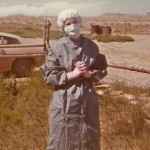
 From the time she was a Candy Striper at the age of seventeen, my sister-in-law, Jennifer Parmely knew that she wanted to be a nurse…a Labor and Delivery Nurse, to be exact. After graduating from high school, she set out to begin her journey to make that dream happen. She became a nurse and was hired at what is now Banner Wyoming Medical Center in Casper. Jennifer was in her element, and so began a 45-year long career. She continued her education to the point where she could have a supervisory position and teach classes to fellow nurses, but her first love was being there when new babies were born. She was there when each of my grandchildren, Chris Petersen, Shai Royce, Caalab Royce, and Josh Petersen were born, as well as many other people I know. My girls, Corrie Petersen and Amy Royce were grateful to have their aunt there with them, as was I.
From the time she was a Candy Striper at the age of seventeen, my sister-in-law, Jennifer Parmely knew that she wanted to be a nurse…a Labor and Delivery Nurse, to be exact. After graduating from high school, she set out to begin her journey to make that dream happen. She became a nurse and was hired at what is now Banner Wyoming Medical Center in Casper. Jennifer was in her element, and so began a 45-year long career. She continued her education to the point where she could have a supervisory position and teach classes to fellow nurses, but her first love was being there when new babies were born. She was there when each of my grandchildren, Chris Petersen, Shai Royce, Caalab Royce, and Josh Petersen were born, as well as many other people I know. My girls, Corrie Petersen and Amy Royce were grateful to have their aunt there with them, as was I.
February 28, 2023, marked the end of Jennifer’s career, when she retired from nursing to pursue her other  loves, hiking, bicycling, skiing, traveling (mostly to hike), and spending time at the cabin she and her partner, Brian Cratty own on Casper Mountain, and of course, time with her grandchildren, Reagan, Hattie, Bowen, and Maeve Parmely. We couldn’t be happier for Jennifer, but I find myself wondering how Banner Wyoming Medical Center has changed since her departure. Let’s face it, Jennifer was a fixture at that hospital. She worked during deliveries, sometimes even being the one to actually deliver the baby. She took care of babies after their birth, and in the nursery. She took care of the moms after they had given birth. And, inevitably, she was there when some babies didn’t make it. Mostly Labor and Delivery is a happy place, but when moms or babies are lost, it becomes the very saddest of places.
loves, hiking, bicycling, skiing, traveling (mostly to hike), and spending time at the cabin she and her partner, Brian Cratty own on Casper Mountain, and of course, time with her grandchildren, Reagan, Hattie, Bowen, and Maeve Parmely. We couldn’t be happier for Jennifer, but I find myself wondering how Banner Wyoming Medical Center has changed since her departure. Let’s face it, Jennifer was a fixture at that hospital. She worked during deliveries, sometimes even being the one to actually deliver the baby. She took care of babies after their birth, and in the nursery. She took care of the moms after they had given birth. And, inevitably, she was there when some babies didn’t make it. Mostly Labor and Delivery is a happy place, but when moms or babies are lost, it becomes the very saddest of places.
Now, those hands that helped deliver babies have other jobs to pursue…or maybe no jobs at all. She will still get to hold babies, of course, because our family is always growing. In fact, I have two great grandbabies on 
 the way right now. Jennifer will have the opportunity to hold these new little ones, but no more deliveries…unless she comes upon an emergency situation somewhere, that places her back in the position of delivering a baby. Actually, we hope that never happens, because it is traumatic for everyone, but if it did, the mommy and baby would be blessed if Jennifer were the one helping. I’m sure the hospital and all of her co-workers miss her very much, but she is on to new adventures. Today is Jennifer’s birthday. Happy birthday Jennifer!! Have a great day!! We love you!!
the way right now. Jennifer will have the opportunity to hold these new little ones, but no more deliveries…unless she comes upon an emergency situation somewhere, that places her back in the position of delivering a baby. Actually, we hope that never happens, because it is traumatic for everyone, but if it did, the mommy and baby would be blessed if Jennifer were the one helping. I’m sure the hospital and all of her co-workers miss her very much, but she is on to new adventures. Today is Jennifer’s birthday. Happy birthday Jennifer!! Have a great day!! We love you!!

 While escape seemed impossible, there were a number of successful escapes from the horrific Nazi death camp known as Auschwitz. Unfortunately, there were also many failed attempts. These escapes and attempted escapes happened, because where people are held in captivity, they will rebel and try to find a way out, and when death is inevitable, escape become less risky. Hitler wanted all the Jews dead, and while he might have tried to hide his true intentions from the world, he certainly didn’t hide it from the Jews themselves.
While escape seemed impossible, there were a number of successful escapes from the horrific Nazi death camp known as Auschwitz. Unfortunately, there were also many failed attempts. These escapes and attempted escapes happened, because where people are held in captivity, they will rebel and try to find a way out, and when death is inevitable, escape become less risky. Hitler wanted all the Jews dead, and while he might have tried to hide his true intentions from the world, he certainly didn’t hide it from the Jews themselves.
Most prisoner escapes took place from worksites outside the camp. The attitude of local civilians was of immense importance in the success of these efforts. Some of the escapees tried to get the word out that the camps were not just work camps, but were also death camps, and that the people should fight with everything they had to avoid going. Of course, all too often, any reports were suppressed as much as possible by the Germans, and for the most part, the reports did little to no good.
On escape that particularly touched me was the escape of two Slovakian Jews, Rudolf Vrba (born Walter Rosenberg) and Alfred Wetzler, escaped in April 1944. They knew the consequences of the were caught, and the men in their barracks knew the consequences of helping them, or even being in the same barracks with them. Nevertheless, all of them felt that the risk was worth it to try to get the truth to the outside world.
Trust was vital, in an escape. Vrba and Wetzler came from the same town, so they knew each other well, and could trust each other. The men had been working on this escape idea for a while, coming up with plans and then rejecting them, because they couldn’t work. Finally, Wetzler came to Vrba with a plan that just might work. They would hide in a pile of wooden planks and after the three-day search for the escapees was finished,  they would escape and head South. The plan was good, but there were still a number of obstacles to maneuver. The first group to attempt the escape were later caught in a village south of the camp, but the wooden plank plan had worked, and the captured prisoners did not reveal their strategy.
they would escape and head South. The plan was good, but there were still a number of obstacles to maneuver. The first group to attempt the escape were later caught in a village south of the camp, but the wooden plank plan had worked, and the captured prisoners did not reveal their strategy.
So, Vrba and Wetzler waited two weeks, and put their plan in motion. The had a friend help them by pulling the planks over then, and covering the area with something to hid e the scent of the men from the dogs. The men expected the alarm to sound at the 5:30pm roll call, but no alarm sounded. The men began to think that someone had told of their location, and that the guards would be coming any minute, but the alarm went of shortly after 6:00pm and the sound of boots and dogs was everywhere. It was all they could do not to scream in terror. Nevertheless, they held their peace and stayed put.
The men laid motionless for three days with no food or water. They were stiff and cold, but finally, they heard the guards call off the search, so that night they decided to come out of the wood pile and make their escape. However, the planks wouldn’t budge. They pushed and pushed…almost to the point of panic. They determined that they would not die there, they gave it one last effort, and the planks gave way. They came out into the night, made their way to the nearest fence and crawled under the barbed wire. I’m quite sure they never wanted to see a fence again.
The ran for the woods, traveling at night, and hiding by day. They were seen by a few people, but thankfully everyone who saw them was sympathetic to their cause and helped them on their way. Finally, they crossed the 
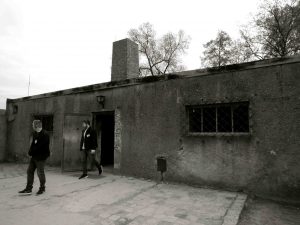 border, and they were free at last. They went to Zylina, where they met secretly with officials from the Slovakia Jewish Council and gave them a secret report on Auschwitz. An in-depth report was drawn up in Slovak and German. The plan was to get the report to the world before another train load of Jews could come to Auschwitz, and the men had done their part. They had done all they could. Unfortunately, the report did not get to those who needed to hear it, and the killing would go on until January 27, 1945, when Auschwitz was finally liberated.
border, and they were free at last. They went to Zylina, where they met secretly with officials from the Slovakia Jewish Council and gave them a secret report on Auschwitz. An in-depth report was drawn up in Slovak and German. The plan was to get the report to the world before another train load of Jews could come to Auschwitz, and the men had done their part. They had done all they could. Unfortunately, the report did not get to those who needed to hear it, and the killing would go on until January 27, 1945, when Auschwitz was finally liberated.

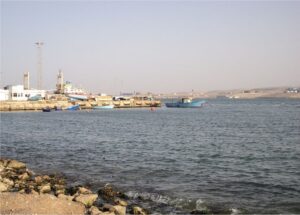 During World WarII, and probably any war, port cities are vital for the transportation of weapons, machinery, and personnel. The port city of Tobruk on Libya’s eastern Mediterranean coast is near the border with Egypt. In World War II, that may not have seemed like a particularly important port, but the Germans must have seen it as such, because in November of 1941, the Nazis laid siege to the capital of the Butnan District (previously the Tobruk District), and home to approximately 120,000 people today (although the population in 1941 was likely less).
During World WarII, and probably any war, port cities are vital for the transportation of weapons, machinery, and personnel. The port city of Tobruk on Libya’s eastern Mediterranean coast is near the border with Egypt. In World War II, that may not have seemed like a particularly important port, but the Germans must have seen it as such, because in November of 1941, the Nazis laid siege to the capital of the Butnan District (previously the Tobruk District), and home to approximately 120,000 people today (although the population in 1941 was likely less).
Tobruk began its existence as an ancient Greek colony, but later became a Roman fortress guarding the frontier of Cyrenaica. I suppose that qualifies as an important port. Tobruk became a waystation along the coastal caravan route, over the centuries. It became an Italian military post by 1911. Then, during World War II, Allied forces, mainly the Australian 6th Division, saw it a the perfect spot for a military base, and they took Tobruk on January 22, 1941. They reached Tobruk on April 9, 1941. At that time, there was prolonged fighting against German and Italian forces. Tobruk has a strong, naturally protected deep harbor. It is probably the best natural port in northern Africa. It wasn’t as popular, because it wasn’t near any landsites.
In 1941, Axis forces took over Tobruk, in a siege that would last for 241 days. The Axis forces advanced through Cyrenaica from El Agheila in Operation Sonnenblume against Allied forces in Libya, during the Western Desert Campaign of 1940–1943 in World War II. The Allies had defeated the Italian 10th Army during Operation Compass that took place between December 9, 1940 and February 9, 1941, and trapped the remnants of the troops at Beda Fomm. Much of the Western Desert Force (WDF) was sent to the Greek and Syrian campaign in early 1941. By the time German troops and Italian reinforcements reached Libya, only a skeleton Allied force remained, and they were short of equipment and supplies. It was then that the Australian 9th Division became known as “The Rats of Tobruk” when they pulled back to Tobruk to avoid encirclement after actions at Er 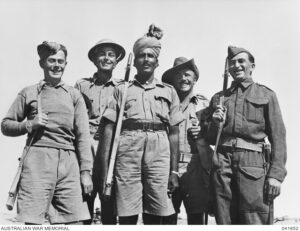
 Regima and Mechili. Although the siege was lifted by Operation Crusader in November 1941, a renewed offensive by Axis forces under Erwin Rommel the following year resulted in Tobruk being re-captured in June 1942 and held by the Axis forces until November 1942, when it was finally recaptured by the Allies. Rebuilt after World War II, Tobruk was later expanded during the 1960s to include a port terminal linked by an oil pipeline to the Sarir oil field.
Regima and Mechili. Although the siege was lifted by Operation Crusader in November 1941, a renewed offensive by Axis forces under Erwin Rommel the following year resulted in Tobruk being re-captured in June 1942 and held by the Axis forces until November 1942, when it was finally recaptured by the Allies. Rebuilt after World War II, Tobruk was later expanded during the 1960s to include a port terminal linked by an oil pipeline to the Sarir oil field.

 For many people, the events of Good Friday, while not forgotten exactly, are “misplaced” with the upcoming commercial holiday of modern Easter. Of course, Easter or Resurrection Day, as it should be called, could not be possible, were it not for the events of Good Friday. Our world was headed for disaster. Our sins had separated us from God, and we had no way to ever get back, because the Bible tells us that “the wages of sin is death.” We couldn’t “un-sin” and so the only destination left for our lives was Hell. It was where we would all go, if something was not done to save us.
For many people, the events of Good Friday, while not forgotten exactly, are “misplaced” with the upcoming commercial holiday of modern Easter. Of course, Easter or Resurrection Day, as it should be called, could not be possible, were it not for the events of Good Friday. Our world was headed for disaster. Our sins had separated us from God, and we had no way to ever get back, because the Bible tells us that “the wages of sin is death.” We couldn’t “un-sin” and so the only destination left for our lives was Hell. It was where we would all go, if something was not done to save us.
Jesus was the only way out. He lived a sinless life, and yet accepted the beating, torture, and death on the cross, because He could see the reward in the end…the restoration of all mankind to a relationship with God again. Why did Jesus accept that horrific punishment? He did it for me…and you, and all mankind, and He purchased that salvation for anyone who wants it. I have often wondered why they called it Good Friday, but even though the death of Jesus was horrific, it was the best day ever…for mankind, anyway.
Resurrection Day is the day when the horrific job given to Jesus was completed. When He rose from the dead  on that third day, He rose in victory, having completed the task of redeeming us from the curse of the law. God knew that we couldn’t live perfect, and with Adam’s sin, and every sin that followed, we became more and more filthy and disgusting, but God so loved the world, that He gave his only begotten Son, that whosoever believes on Him shall be saved. When we accept Jesus as our Lord and Savior, we are instantly put back in right standing with God. We can live out eternity in Heaven and not in Hell. It is the greatest gift of all time, and it is ours for the taking. Salvation is waiting for everyone!! We only need to believe. Happy Resurrection Day everyone!! Praise God, Jesus is risen!!
on that third day, He rose in victory, having completed the task of redeeming us from the curse of the law. God knew that we couldn’t live perfect, and with Adam’s sin, and every sin that followed, we became more and more filthy and disgusting, but God so loved the world, that He gave his only begotten Son, that whosoever believes on Him shall be saved. When we accept Jesus as our Lord and Savior, we are instantly put back in right standing with God. We can live out eternity in Heaven and not in Hell. It is the greatest gift of all time, and it is ours for the taking. Salvation is waiting for everyone!! We only need to believe. Happy Resurrection Day everyone!! Praise God, Jesus is risen!!
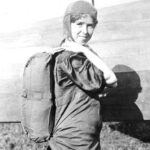
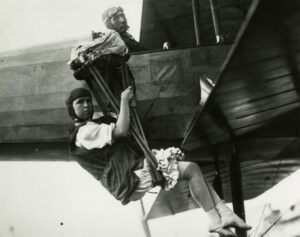 Personally, I see no reason to jump out of a perfectly good airplane, but I know that there are countless numbers of people who absolutely love the thrill of doing just that. In fact, before planes were invented there were parachutes. In 1783, gutsy inventor Louis-Sebastian Lourmand made the first-ever recorded successful parachute jump with a rigid-frame cloth parachute 14 feet in diameter. He, of course, jumped from a balloon, because there were no planes then. I can’t imagine how that jump went. The parachute was not soft and flexible, but rigid!! My mind can see so many things going wrong with that jump. In the early years of parachute jumping, the jumpers were men, because women were considered far too “fragile” and “delicate” for such activities, so I doubt if it would have even been allowed, had a woman asked.
Personally, I see no reason to jump out of a perfectly good airplane, but I know that there are countless numbers of people who absolutely love the thrill of doing just that. In fact, before planes were invented there were parachutes. In 1783, gutsy inventor Louis-Sebastian Lourmand made the first-ever recorded successful parachute jump with a rigid-frame cloth parachute 14 feet in diameter. He, of course, jumped from a balloon, because there were no planes then. I can’t imagine how that jump went. The parachute was not soft and flexible, but rigid!! My mind can see so many things going wrong with that jump. In the early years of parachute jumping, the jumpers were men, because women were considered far too “fragile” and “delicate” for such activities, so I doubt if it would have even been allowed, had a woman asked.
That all changed when a little woman named Georgia “Tiny” Broadwick came on the scene. Born to parents George and Emma Ross on April 8, 1893, Georgia Ann Thompson weighed about 3 pounds. She was the last of seven daughters, and because of her size, she was given the nickname “Tiny” since she weighed only 85 pounds and was 4 feet 8 inches tall, when she was fully grown. In those days, women often married very young, and at age 12, Tiny Broadwick had married and, at 13, had a daughter, Verla Jacobs (later, Poythress). By 15, Broadwick was abandoned by her husband and working in a cotton mill. It was then that she saw Charles Broadwick’s World Famous Aeronauts parachute from a hot air balloon. She was hooked and decided to join the travelling troupe. She left her daughter in the care of her parents. She later actually became Broadwick’s adopted daughter, to ease travel arrangements. Rumors also flew that she was his wife, but although her own family was later unclear on the relationship, that was not proven.
Although she would eventually make her jumps from airplanes, in her early career Broadwick jumped from balloons. Nevertheless, when the time came, Georgia “Tiny” Broadwick was not afraid, and she became the first woman to jump from an airplane too. She loved parachuting, and between 1913 and 1922 she completed over 1,100 jumps. Making that many jumps taught her that parachutes needed some improvements. So, she invented the ripcord, which is standard on every parachute to this day. Broadwick is also the only female member of the Early Birds of Aviation.
In 1914, she demonstrated parachutes to the US Army. At that time, the Army had a small fleet, but they were just as likely to crash as fly. I suppose that in that situation, knowing how to get out of the plane was crucial. Nevertheless, the Army was reluctant to adopt the parachute at first. They watched Tiny fearlessly dropped 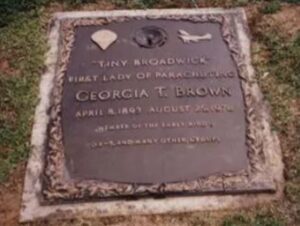
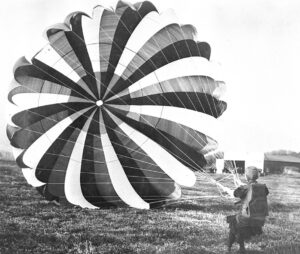 from the sky. Then, on one of her demonstration jumps, the static line became entangled in the tail assembly of the aircraft. As a solution, Tiny cut off the static line and deployed her chute manually on her next jump, thus becoming the first person to jump free-fall. This demonstrated that pilots could escape aircraft by using what was later called a ripcord, and for that she is now famous. Broadwick died in 1978 and was buried in Sunset Gardens in Henderson, North Carolina.
from the sky. Then, on one of her demonstration jumps, the static line became entangled in the tail assembly of the aircraft. As a solution, Tiny cut off the static line and deployed her chute manually on her next jump, thus becoming the first person to jump free-fall. This demonstrated that pilots could escape aircraft by using what was later called a ripcord, and for that she is now famous. Broadwick died in 1978 and was buried in Sunset Gardens in Henderson, North Carolina.

 My niece, Chantel Balcerzak was the first grandchild of my parents, Al and Collene Spencer. From the start, Chantel was a Diva, and very girly. She could have been a model of baby clothes. She was almost always in a pose. Chantel always had so much going for her. She was everything lots of girls wanted to be. She was cute and petite, 4’10” fully grown. She had a super smile, and you couldn’t help but smile with her.
My niece, Chantel Balcerzak was the first grandchild of my parents, Al and Collene Spencer. From the start, Chantel was a Diva, and very girly. She could have been a model of baby clothes. She was almost always in a pose. Chantel always had so much going for her. She was everything lots of girls wanted to be. She was cute and petite, 4’10” fully grown. She had a super smile, and you couldn’t help but smile with her.
Of course, Chantel has other things going for her. Chantel has a wonderful imagination…both for stories and for art. As she has grown, Chantel’s imagination has grown, and developed into a love of art. She is so creative, and her art is stunning. Recently, Chantel has been painting murals for people around town, and her mural business is really growing. Painting a mural is no easy job. It takes a lot of planning. I’m sure that Chantel started on her own walls, and she has painted so really beautiful murals for her 
 home. The other people heard about her murals, and her business took off.
home. The other people heard about her murals, and her business took off.
Chantel also has a wedding business. She doesn’t do the whole wedding, but the flowers, and other decorations. This year she already has flowers for two weddings lined up. She is very skilled at floral arrangements, and word of mouth is one of the best ways to advertise, so her business has really grown.
Chantel and her daughter, Siara Kirk have been working out together for a couple of years now, and they are both crazy strong. they do a lot of the heavy lifting, and they are really good at it. They try to work out during 
 lunch breaks, which kills two birds with one stone. They get their workout in, and they eat less food at lunch. It’s a win-win!! Siara is so proud of her mom’s tenacity.
lunch breaks, which kills two birds with one stone. They get their workout in, and they eat less food at lunch. It’s a win-win!! Siara is so proud of her mom’s tenacity.
Chantel is a woman of strong faith. No matter what comes her way, she prays over it and then patiently waits on God to take care of the situation. She has passed that strong faith on to her husband, Dave Balcerzak, and her children. Her strength and her faith have made them very proud too. Chantel and Dave are not only husband and wife…they are best friends. Her daughter, Siara says she is her best friend as well, and always has been. And her sisters dearly love her. Today is Chantel’s birthday. Happy birthday Chantel!! Have a great day!! We love you!!

